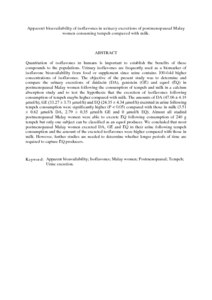Citation
Haron, Hasnah and Ismail, Amin and Shahar, Suzana and Azlan, Azrina and Loh, Su Peng
(2011)
Apparent bioavailability of isoflavones in urinary excretions of postmenopausal Malay women consuming tempeh compared with milk.
International Journal of Food Sciences and Nutrition, 62 (6).
pp. 642-650.
ISSN 0963-7486; ESSN: 1465-3478
Abstract
Quantitation of isoflavones in humans is important to establish the benefits of these compounds to the populations. Urinary isoflavones are frequently used as a biomarker of isoflavone bioavailability from food or supplement since urine contains 100-fold higher concentrations of isoflavones. The objective of the present study was to determine and compare the urinary excretions of daidzein (DA), genistein (GE) and equol (EQ) in postmenopausal Malay women following the consumption of tempeh and milk in a calcium absorption study and to test the hypothesis that the excretion of isoflavones following consumption of tempeh maybe higher compared with milk. The amounts of DA (47.06 ± 4.18 μmol/h), GE (33.27 ± 3.71 μmol/h) and EQ (24.35 ± 4.34 μmol/h) excreted in urine following tempeh consumption were significantly higher (P < 0.05) compared with those in milk (3.51 ± 0.62 μmol/h DA, 2.79 ± 0.35 μmol/h GE and 0 μmol/h EQ). Almost all studied postmenopausal Malay women were able to excrete EQ following consumption of 240 g tempeh but only one subject can be classified as an equol producer. We concluded that most postmenopausal Malay women excreted DA, GE and EQ in their urine following tempeh consumption and the amount of the excreted isoflavones were higher compared with those in milk. However, further studies are needed to determine whether longer periods of time are required to capture EQ producers.
Download File
![[img]](http://psasir.upm.edu.my/24465/1.hassmallThumbnailVersion/Apparent%20bioavailability%20of%20isoflavones%20in%20urinary%20excretions%20of%20postmenopausal%20Malay%20women%20consuming%20tempeh%20compared%20with%20milk.pdf)  Preview |
|
PDF (Abstract)
Apparent bioavailability of isoflavones in urinary excretions of postmenopausal Malay women consuming tempeh compared with milk.pdf
Download (189kB)
| Preview
|
|
Additional Metadata
Actions (login required)
 |
View Item |

